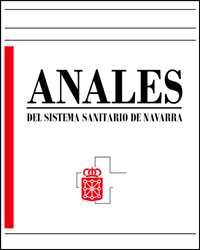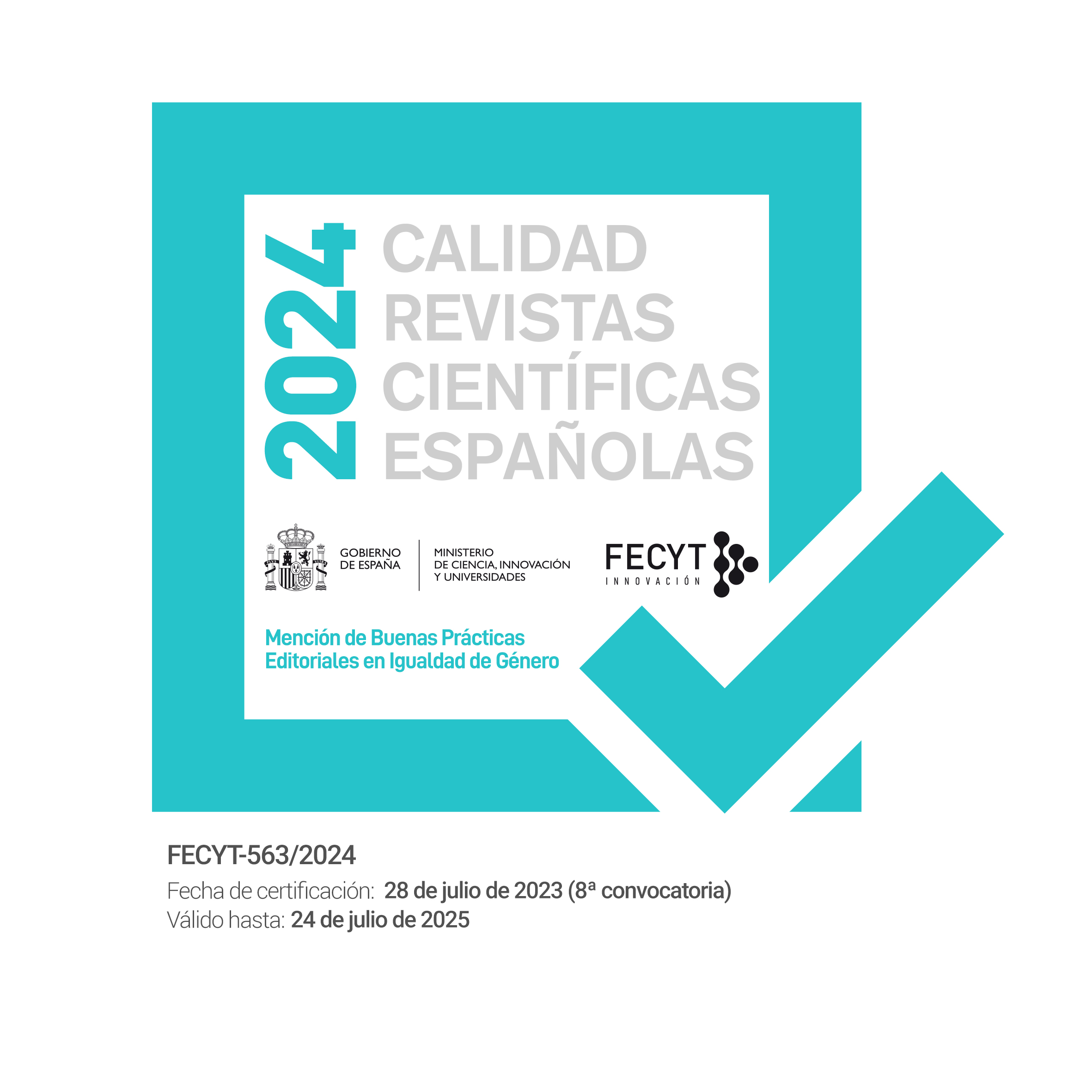Impacto de la atención farmacéutica en pacientes polimedicados ingresados en un servicio de Geriatría
DOI:
https://doi.org/10.23938/ASSN.0990Palabras clave:
Pluripatología, Polifarmacia, Intervención farmacéutica, Problemas relacionados con los medicamentos, STOPP-START v.2Resumen
Fundamento. Estimar la prevalencia de prescripción potencialmente inadecuada (PPI) y de problemas relacionados con los medicamentos (PRM) en pacientes ancianos polimedicados hospitalizados, y evaluar el impacto de la intervención farmacéutica sobre dicha prevalencia.
Material y métodos. Estudio de intervención, cuasi-experimental, en pacientes polimedicados (≥ 6 fármacos) que ingresaron en un servicio de Geriatría en 2018-2019. Se analizaron las PPI según criterios STOPP/START 2014 y los PRM según el Tercer Consenso de Granada. Los PPI y PRM detectados, junto con posibles acciones para solucionarlos, se remitieron al geriatra responsable. Si al alta el cambio en la prevalencia de PPI y PRM fue ≥75%, se consideró aceptada la intervención.
Resultados. Se realizó intervención farmacéutica en 218 pacientes, analizándose 1.837 prescripciones. Al ingreso se observaron PPI (90,8%) y PRM (99,5%). Se realizaron 1.227 intervenciones, el 57,6% sobre PRM. Se aceptó el 53,6% de las intervenciones farmacéuticas; la PPI según criterios STOPP y START se redujo un 49,7 y un 22,1%, respectivamente; los PRM disminuyeron un 60,1%. Las frecuencias y medianas de PRM y de PPI según criterios START y STOPP se redujeron significativamente al alta. Las variables más asociadas con la aceptación de la intervención farmacéutica fueron el geriatra responsable, el número de PPI START y el número de PPI STOPP.
Conclusiones. Durante el ingreso hospitalario, la detección de PPI y PRM del tratamiento crónico por el farmacéutico, y en colaboración con el médico del paciente, ayuda a disminuir, la prevalencia de PPI y PRM.
Descargas
Citas
BELLVER MONZÓ O, MORENO ROYO L, SALAR IBÁÑEZ L. Prescripciones potencialmente inadecuadas en pacientes ancianos polimedicados. Intervención y seguimiento del farmacéutico comunitario. Farm Comunitarios 2018; 10: 5-14. https://doi.org/10.5672/FC.2173-9218.(2018/Vol10).002.02
HERNÁNDEZ RODRÍGUEZ MÁ, SEMPERE VERDÚ E, VICENS CALDENTEY C, GONZÁLEZ RUBIO F, MIGUEL GARCÍA F, PALOP LARREA V et al. Evolution of polypharmacy in a Spanish population (2005-2015): a database study. Pharmacoepidemiol Drug Saf 2020; 29: 433-443. https://doi.org/10.1002/pds.4956
GONZÁLEZ-ROJANO E, MARCOTEGUI J, SAMPEDRO R, VALDEZ-ACOSTA S, ABAD-SANTOS F. Utility of a computer tool for detection of potentially inappropriate medications in older patients in a tertiary hospital. IBJ Clin Pharmacol 2020; 1: 00013. https://doi.org/10.24217/2530-4984.20v1s1.00013
VILLAFAINA BARROSO A, GAVILÁN MORAL E. Pacientes polimedicados frágiles, un reto para el sistema sanitario. Inf Ter Sist Nac Salud 2011; 35: 114-232. https://www.mscbs.gob.es/biblioPublic/publicaciones/recursos_propios/infMedic/docs/PolimedicadosVol35n4.pdf
DELGADO SILVEIRA E, MONTERO ERRASQUÍN B, MUÑOZ GARCÍA M, VÉLEZ-DÍAZ-PALLARÉS M, LOZANO MONTOYA I, SÁNCHEZ-CASTELLANO C et al. Mejorando la prescripción de medicamentos en las personas mayores: una nueva edición de los criterios STOPP-START. Rev Esp Geriatría Gerontol 2015; 50: 89-96. https://doi.org/10.1016/j.regg.2014.10.005
GÓMEZ-CORTIJO R, FLOTATS-DAM P, IPARRAGUIRRE-AZCONA MK, CUBÍ-MONTANYÀ D, SABARTÉS-FORTUNY O, CASTELLARNAU-FONT A et al. Adecuación de la prescripción farmacológica durante el ingreso en un centro sociosanitario: experiencia clínica con los criterios STOPP/START. J Health Qual Res 2020; 35: 95-101. https://doi.org/10.1016/j.jhqr.2020.02.001
RUIZ-MILLO O, CLIMENTE-MARTÍ M, NAVARRO-SANZ JR. Improvement on prescribing appropriateness after implementing an interdisciplinary pharmacotherapy quality programme in a long-term care hospital. Eur J Hosp Pharm 2018; 25: 267-273. https://doi.org/10.1136/ejhpharm-2017-001411
Comité de Consenso. Tercer Consenso de Granada sobre problemas relacionados con medicamentos (PRM) y resultados negativos asociados a la medicación (RNM). Ars Pharm 2007; 48: 5-17.
SANTOS-RAMOS B, OTERO-LÓPEZ MJ, GALVÁN-BANQUERI M, ALFARO-LARA ER, VEGA-COCA MD, NIETO-MARTÍN MD et al. Modelos de atención al paciente pluripatológico y el papel de la farmacia hospitalaria. Farm Hosp 2012; 36: 506-517. https://doi.org/10.7399/FH.2012.36.6.52
DELGADO SILVEIRA E, FERNÁNDEZ-VILLALBA EM, GARCÍA-MINA FREIRE M, ALBIÑANA PÉREZ MS, CASAJÚS LAGRANJA MP, PERIS MARTÍ JF. Impacto de la intervención farmacéutica en el tratamiento del paciente mayor pluripatológico. Farm Hosp 2015; 39: 192-202. https://doi.org/10.7399/fh.2015.39.4.8329
PARDO-CABELLO AJ, BERMUDO-CONDE S, MANZANO-GAMERO V. Prescripción potencialmente inapropiada en pacientes hospitalizados con estudio comparativo entre la prescripción realizada por internistas y geriatras. Farm Hosp 2014; 38: 65-68. https://doi.org/10.7399/FH.2014.38.1.871
FERNÁNDEZ REGUEIRO R, ESTRADA MENÉNDEZ C, MORÍS DE LA TASSA J. Impacto de un programa de intervención destinado a la mejora de la prescripción potencialmente inapropiada en pacientes ancianos hospitalizados. Rev Clínica Esp 2019; 219: 375-385. https://doi.org/10.1016/j.rce.2018.12.012
GAVILÁN-MORAL E, VILLAFAINA-BARROSO A, JIMÉNEZ-DE GRACIA L, GÓMEZ SANTANA MC. Ancianos frágiles polimedicados: ¿es la deprescripción de medicamentos la salida? Rev Esp Geriatría Gerontol 2012; 47: 162-167. https://doi.org/10.1016/j.regg.2012.01.003
LOZANO-MONTOYA I, VÉLEZ-DIAZ-PALLARÉS M, DELGADO-SILVEIRA E, MONTERO-ERRASQUIN B, CRUZ JENTOFT AJ. Potentially inappropriate prescribing detected by STOPP–START criteria: are they really inappropriate? Age Ageing 2015; 44: 861-866. https://doi.org/10.1093/ageing/afv079
DELGADO SILVEIRA E, ÁLVAREZ DÍAZ A, PÉREZ MENÉNDEZ-CONDE C, MUÑOZ GARCÍA M, CRUZ-JENTOFT A, BERMEJO VICEDO T. Resultados de la integración de la atención farmacéutica en una Unidad de Agudos de Geriatría. Rev Esp Geriatría Gerontol 2012; 47: 49-54. https://doi.org/10.1016/j.regg.2011.11.012
RODRÍGUEZ DEL RÍO E, PERDIGONES J, FUENTES FERRER M, GONZÁLEZ DEL CASTILLO J, GONZÁLEZ ARMENGOL J, BORREGO HERNANDO MI et al. Impacto de los resultados a medio plazo de la prescripción inadecuada en los pacientes ancianos dados de alta desde una unidad de corta estancia. Aten Primaria 2018; 50: 467-476. https://doi.org/10.1016/j.aprim.2017.03.018
DÍAZ-GONZÁLEZ A, MORERA-HERRERAS T, MEDIBIL-CRESPO I, PISÓN J, MARTÍN-LESENDE I. Prescripción inadecuada, crónica y a demanda, en pacientes pluripatológicos ≥65 años según los criterios STOPP-START. Gac Med Bilbao 2018; 115: 45-57.
THEVELIN S, MOUNAOUAR LE, MARIEN S, BOLAND B, HENRARD S, DALLEUR O. Potentially inappropriate prescribing and related hospital admissions in geriatric patients: a comparative analysis between the STOPP and START criteria versions 1 and 2. Drugs Aging 2019; 36: 453-459. https://doi.org/10.1007/s40266-018-00635-8
DAMOISEAUX-VOLMAN BA, MEDLOCK S, RAVEN K, SENT D, ROMIJN JA, VAN DER VELDE N et al. Potentially inappropriate prescribing in older hospitalized Dutch patients according to the STOPP/START criteria v2: a longitudinal study. Eur J Clin Pharmacol 2021; 77: 777-785. https://doi.org/10.1007/s00228-020-03052-2
THOMAS RE, THOMAS BC. A systematic review of studies of the STOPP/START 2015 and American Geriatric Society Beers 2015 criteria in patients ≥ 65 years. Curr Aging Sci 2019; 12: 121-154. https://doi.org/10.2174/1874609812666190516093742
SALGUEIRO E, ELIZARDE BC, ELOLA AI, GARCÍA-PULIDO B, NICIEZA-GARCÍA ML, MANSO G. Los criterios STOPP/START más frecuentes en España. Una revisión de la literatura. Rev Esp Geriatría Gerontol 2018; 53: 274-278. https://doi.org/10.1016/j.regg.2018.03.001
MA Z, TONG Y, ZHANG C, LIU L. Potentially inappropriate medications and potentially prescribing omissions in Chinese older patients: Comparison of two versions of STOPP/START. J Clin Pharm Ther. 2020; 45: 1405-1413. https://doi.org/10.1111/jcpt.13237
BLANCO-REINA E, GARCÍA-MERINO MR, OCAÑA-RIOLA R, AGUILAR-CANO L, VALDELLÓS J, BELLIDO-ESTÉVEZ I et al. Assessing potentially inappropriate prescribing in community-dwelling older patients using the updated version of STOPP-START criteria: a comparison of profiles and prevalences with respect to the original version. Plos One 2016; 11: e0167586. https://doi.org/10.1371/journal.pone.0167586
ENA J. Reducción del número de prescripciones inadecuadas: comunicación farmacia-prescriptor. Rev Clínica Esp 2019; 219: 401-402. https://doi.org/10.1016/j.rce.2019.03.001
GUTIÉRREZ VALENCIA M, MARTÍNEZ VELILLA N, LACALLE FABO E, BEOBIDE TELLERIA I, LARRAYOZ SOLA B, TOSATO M. Intervenciones para optimizar el tratamiento farmacológico en ancianos hospitalizados: una revisión sistemática. Rev Clínica Esp 2016; 216: 205-221. https://doi.org/10.1016/j.rce.2016.01.005
GUERRO-PRADO M. Prevalencia de problemas relacionados con la medicación en pacientes crónicos pluripatológicos complejos y oportunidades de mejora. Farm Hosp 2018; 42: 197-199. https://doi.org/10.7399%2Ffh.10899
HAILU BY, BERHE DF, GUDINA EK, GIDEY K, GETACHEW M. Drug related problems in admitted geriatric patients: the impact of clinical pharmacist intervention. BMC Geriatr 2020; 20: 13. https://doi.org/10.1186/s12877-020-1413-7
INIESTA-NAVALÓN C, URBIETA-SANZ E, GASCÓN-CÁNOVAS JJ. Análisis de las interacciones medicamentosas asociadas a la farmacoterapia domiciliaria en pacientes ancianos hospitalizados. Rev Clínica Esp 2011; 211: 344-351. https://doi.org/10.1016/j.rce.2011.04.005
GALINDO-OCAÑA J, GIL-NAVARRO MV, GARCÍA-MORILLO JS, BERNABEU-WITTEL M, OLLERO-BATURONE M, ORTIZ-CAMUNEZ MA. Interacciones medicamentosas en pacientes pluripatológicos. Rev Clin Esp 2010; 210: 270-278. https://doi.org/10.1016/j.rce.2009.12.008
O’SULLIVAN D, O’MAHONY D, O’CONNOR MN, GALLAGHER P, CULLINAN S, O’SULLIVAN R et al. The Impact of a Structured Pharmacist Intervention on the Appropriateness of Prescribing in Older Hospitalized Patients. Drugs Aging 2014; 31: 471-481. https://doi.org/10.1007/s40266-014-0172-6
ACOSTA-GARCIA H, ALFARO-LARA E, SÁNCHEZ-FIDALGO S, SEVILLA-SÁNCHEZ D, DELGADO-SILVEIRA E, JUANES-BORREGO A, SANTOS-RAMOS B. Intervention effectiveness by pharmacists integrated within an interdisciplinary health team on chronic complex patients. Eur J Public Health 2020; 30: 886-899. https://doi.org/10.1093/eurpub/ckz224
Publicado
Cómo citar
Número
Sección
Licencia
Derechos de autor 2022 Anales del Sistema Sanitario de Navarra

Esta obra está bajo una licencia internacional Creative Commons Atribución-CompartirIgual 4.0.
La revista Anales del Sistema Sanitario de Navarra es publicada por el Departamento de Salud del Gobierno de Navarra (España), quien conserva los derechos patrimoniales (copyright ) sobre el artículo publicado y favorece y permite la difusión del mismo bajo licencia Creative Commons Reconocimiento-CompartirIgual 4.0 Internacional (CC BY-SA 4.0). Esta licencia permite copiar, usar, difundir, transmitir y exponer públicamente el artículo, siempre que siempre que se cite la autoría y la publicación inicial en Anales del Sistema Sanitario de Navarra, y se distinga la existencia de esta licencia de uso.








